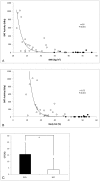Brown adipose tissue in morbidly obese subjects
- PMID: 21390318
- PMCID: PMC3044745
- DOI: 10.1371/journal.pone.0017247
Brown adipose tissue in morbidly obese subjects
Abstract
Background: Cold-stimulated adaptive thermogenesis in brown adipose tissue (BAT) to increase energy expenditure is suggested as a possible therapeutic target for the treatment of obesity. We have recently shown high prevalence of BAT in adult humans, which was inversely related to body mass index (BMI) and body fat percentage (BF%), suggesting that obesity is associated with lower BAT activity. Here, we examined BAT activity in morbidly obese subjects and its role in cold-induced thermogenesis (CIT) after applying a personalized cooling protocol. We hypothesize that morbidly obese subjects show reduced BAT activity upon cold exposure.
Methods and findings: After applying a personalized cooling protocol for maximal non-shivering conditions, BAT activity was determined using positron-emission tomography and computed tomography (PET-CT). Cold-induced BAT activity was detected in three out of 15 morbidly obese subjects. Combined with results from lean to morbidly obese subjects (n = 39) from previous study, the collective data show a highly significant correlation between BAT activity and body composition (P<0.001), respectively explaining 64% and 60% of the variance in BMI (r = 0.8; P<0.001) and BF% (r = 0.75; P<0.001). Obese individuals demonstrate a blunted CIT combined with low BAT activity. Only in BAT-positive subjects (n = 26) mean energy expenditure was increased significantly upon cold exposure (51.5±6.7 J/s versus 44.0±5.1 J/s, P = 0.001), and the increase was significantly higher compared to BAT-negative subjects (+15.5±8.9% versus +3.6±8.9%, P = 0.001), indicating a role for BAT in CIT in humans.
Conclusions: This study shows that in an extremely large range of body compositions, BAT activity is highly correlated with BMI and BF%. BAT-positive subjects showed higher CIT, indicating that BAT is also in humans involved in adaptive thermogenesis. Increasing BAT activity could be a therapeutic target in (morbid) obesity.
Conflict of interest statement
Figures


References
-
- Cannon B, Nedergaard J. Brown adipose tissue: function and physiological significance. Physiol Rev. 2004;84:277–359. - PubMed
-
- Enerback S. Human brown adipose tissue. Cell Metab. 2010;11:248–252. - PubMed
-
- Huttunen P, Hirvonen J, Kinnula V. The occurrence of brown adipose tissue in outdoor workers. Eur J Appl Physiol Occup Physiol. 1981;46:339–345. - PubMed
-
- Astrup A, Bulow J, Madsen J, Christensen NJ. Contribution of BAT and skeletal muscle to thermogenesis induced by ephedrine in man. Am J Physiol. 1985;248:E507–515. - PubMed
Publication types
MeSH terms
LinkOut - more resources
Full Text Sources
Other Literature Sources
Miscellaneous

